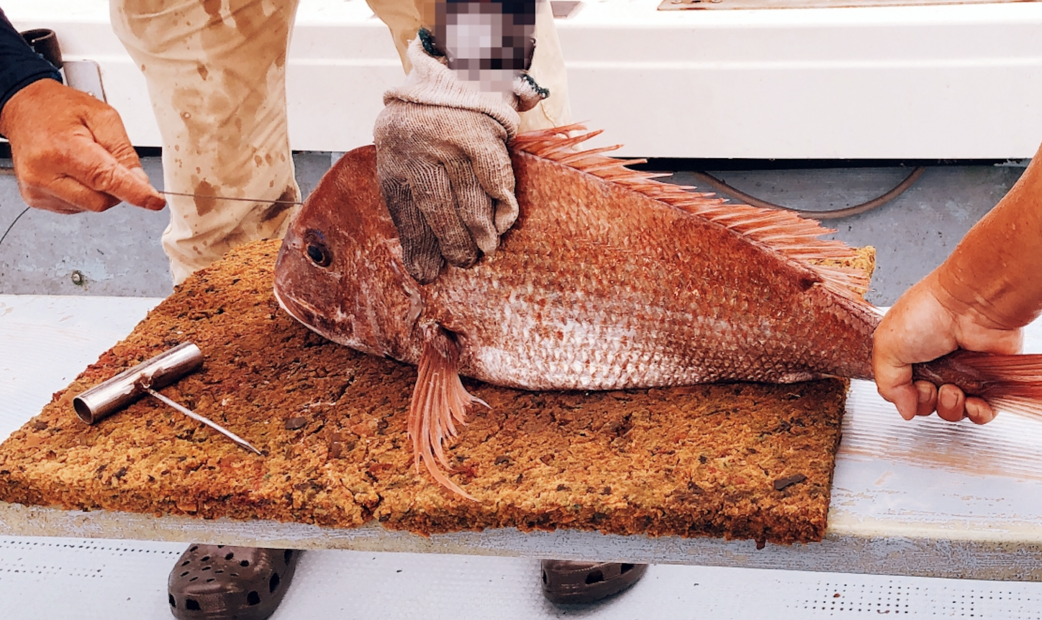
Ikejime, Bleeding, and Why Japanese Sushi Tastes Better
The editorial team at OMAKASE, an official Michelin partner, explores how techniques like ikejime (live fish preparation) and bleeding — key practices behind Edomae sushi — transform the flavor of fish.
Why Is Japanese Sushi So Delicious?
The Art of Ikejime: Japan’s Secret to Perfect Fish
In many parts of the world, eating raw fish isn't part of the culture. Yet in Japan, raw fish is a staple of everyday dining. Why is that? And why does sushi in Japan taste so much better than sushi found elsewhere?
One major reason is ikejime, a technique developed in Japan specifically to maximize the freshness and flavor of raw fish.
Preserving Fish Quality with Ikejime
Ikejime is a traditional technique where a freshly caught fish is quickly and humanely killed to maintain its freshness and enhance its flavor. The longer a fish struggles after being caught, the more its quality declines. Struggling causes bruising, damages the flesh, and disrupts the natural development of flavor compounds.
Sushi Flavor Depends on the Quality of the Ingredients
While the skill of sushi chefs is certainly one reason why sushi in Japan is so delicious, the quality of the fish itself is fundamentally different from what’s used outside of Japan.
Raw fish that hasn’t been properly ikejime-processed often carries a characteristic fishy odor.
In contrast, fish that has been properly ikejime-processed has no fishy smell at all, even when eaten raw.
The Ikejime Process
1. Brain Spiking
The fish is instantly killed by destroying its brain. Specialized tools such as an ice pick or spiking hook are used to pierce the fish’s temple and destroy the brain. Fish processed this way are easier to bleed and stay fresher for longer. After spiking, the fish typically displays an open mouth and a change in eye color.
2. Bleeding
Bleeding involves draining the fish’s blood immediately after brain spiking. Cuts are made near the gills or at the base of the tail, and the fish is then submerged in ice water. This step must be performed while the fish is still alive. If blood remains in the body, it can cause the fish to spoil faster and develop a stronger, unpleasant odor.
(The bleeding process starts at 1:00 in the video.)
3. Spinal Cord Destruction (Neural Spiking)
Following brain spiking, a wire is inserted into the spinal canal to destroy the nerves. This prevents involuntary movements caused by spinal reflexes, minimizing damage to the flesh and preserving the quality of the fish. This technique helps maintain peak freshness and brings out the fish’s natural flavor.
(The neural spiking process starts at 1:10 in the video.)
Flavor and Texture Changes from the Ikejime Technique
Fish treated with the ikejime technique show a noticeable difference in both flavor and texture compared to those that aren't. In terms of taste, ikejime-processed fish develop a deeper, richer umami flavor. This happens because umami compounds naturally form after the fish dies, and by destroying the spinal cord, the onset of decomposition is slowed—allowing more of these compounds to accumulate.
As for texture, ikejime helps preserve the firm, springy quality of freshly caught fish for a longer time. Normally, fish enter rigor mortis soon after death, which causes the flesh to lose its firmness. By delaying this process, ikejime helps retain the ideal texture.
For raw dishes like sashimi, the spinal cord destruction step is crucial for enhancing and preserving the fish’s natural flavor and texture.
How Bleeding Affects Flavor
When preparing fish for raw consumption, bleeding is a crucial step that should never be overlooked. Done immediately after the catch, it helps minimize any fishy odor and significantly preserves the fish’s freshness. One of the challenges, however, is that the optimal degree of bleeding varies depending on the species.
Bleeding White-Fleshed Fish
White-fleshed fish are prized for their translucent, pristine appearance and delicate, mild flavor. To preserve these qualities, it’s essential to remove as much blood as possible during the bleeding process. Inadequate bleeding can lead to blood pooling in the flesh, dulling its clean white color. Moreover, residual blood can introduce a metallic or fishy taste, masking the fish’s natural subtlety and leaving an undesirable odor.
Bleeding Red-Fleshed Fish
Red-fleshed fish are known for their vibrant color and rich, umami-packed flavor. When bleeding these fish, the approach should vary by species. While blood can contribute to a strong fishy smell, it also plays a key role in delivering depth of flavor. For example, over-bleeding tuna can strip it of the robust taste characteristic of its red meat. Conversely, failing to bleed it at all can accelerate spoilage and intensify unpleasant odors. The goal with red-fleshed fish is to find the right balance—removing excess blood to enhance freshness while retaining the richness it imparts.
Aging Fish
When handled properly using techniques like spiking and thorough bleeding, fish can be aged to deepen its flavor and improve its texture. The process typically involves removing highly perishable parts such as the gills and internal organs, then storing the fish in ice water or exposing it to cold air. Aging fish is a delicate craft—it's a process that borders on spoilage and demands both experience and precision. In Japan, aging fish has become increasingly popular in recent years, with some restaurants now specializing in aged sushi made with carefully matured fish.
How Aging Enhances Flavor
As fish ages, its umami compounds increase and excess moisture is drawn out, resulting in a more concentrated flavor. The muscle fibers gradually break down, giving the flesh a tender, almost creamy texture. In white-fleshed fish, aging brings out a subtle sweetness that’s otherwise less pronounced. Tuna is one of the most commonly aged species; in fact, many sushi chefs prefer not to use freshly caught tuna, choosing instead to serve aged cuts. With time, the red meat of tuna becomes more flavorful and melt-in-your-mouth, while fatty cuts like ōtoro take on a cleaner, more refined richness that’s easier to enjoy.
Connection to Edomae Sushi
In Japan, “sushi” often refers to Edomae sushi, the traditional Tokyo-style preparation. Originally developed as a way to preserve fish before refrigeration, Edomae sushi depends heavily on techniques like ikejime to maintain both freshness and flavor. Rather than serving fish immediately after it's caught, Edomae sushi typically uses aged fish to bring out deeper umami. Without ikejime, however, the fish would spoil during the aging process, making this style of sushi impossible to prepare. As such, ikejime remains a foundational technique that underpins the art of modern Edomae sushi.
3 Recommended Sushi Spots in Tokyo
1. Udatsu Sushi (宇田津 鮨) / Sushi
Udatzu Sushi, which earned a Michelin one-star rating in 2023 and was selected again for Michelin in 2025, is a sushi restaurant located in a quiet residential area of Nakameguro. Owner-chef Hisashi Udatsu, who spent 16 years perfecting his craft at renowned establishments in Ginza and Nishi-Azabu, opened the restaurant in 2019 with the unique concept of "Art x Sushi." The refined space, centered around a 150-year-old Yoshino cypress counter, offers the finest Edo-style sushi. The carefully prepared vinegared rice is made with specially sourced rice from contracted farmers and blended with three types of vinegar. A standout dish, the "Seasonal Herb Roll," combines pesticide-free herbs and fresh seasonal fish. The restaurant also offers an exceptional drink pairing curated by a sommelier. With private rooms available, it is the perfect setting for a special dining experience.
- Operation hours
- Lunch:
[Mon–Fri] From 12:00 PM
[Sat, Sun & Public Holidays] From 11:00 AM / From 1:00 PM
Dinner:
From 6:00 PM / From 9:00 PM - Address
- 2-48-10, Kamimeguro, Meguro-ku, Tokyo
- Nearest station
- Nakameguro Station
- Directions from station
- 5-10 minute's walk from Nakameguro Station
- Payment methods
- Cash, Credit card
- Seats
- 1F:9 Counter Seats, 1F 1 Private Room(2~4people)
2F:5 Counter Seats or 2F 1 Private Room(4~8people) - Awards
-
Michelin

-
Jimmy5.0Posted on :11/16/2025
-
Nasser5.0Posted on :11/15/2025
-
Ronny5.0Posted on :11/06/2025
2. Sushi Kanesho (鮓 かね庄)
Sushi Kanesho, listed in the Michelin Guide, is a hidden gem in Asakusa. The owner, drawing on experience from working at renowned restaurants, offers traditional Edomae-sushi. English service is available, making it popular with guests from overseas. The specialty is sushi made with fresh ingredients and rice seasoned with Akasu (red vinegar). The menu features an omakase course, where you can enjoy dishes crafted from carefully selected seasonal ingredients. The alcohol selection, including sake and wine, pairs beautifully with the food. The interior has a modern Japanese style, creating a calm and refined atmosphere.
- Operation hours
- 05:00 PM - 10:00 PM
- Regular holiday
- Mondays, 1st and 3rd Sundays
- Price range
-
Lunch: USD 106.34 - USD 106.34
Dinner: USD 106.34 - USD 177.24 - Address
- 3-33-9 Asakusa, Miyashita Building, 101, Taito-ku, Tokyo
- Nearest station
- Asakusa station
- Directions from station
- 10 minutes walk fron Asakusa station
- Payment methods
- Credit card available
- Seats
- 9 Seats
- Awards
-
Michelin

-
Dardy Chen5.0Posted on :05/25/2025
-
Kaan Tasyurek4.3Posted on :04/10/2025
-
Adriane5.0Posted on :03/08/2025
3. Daikanyama Sushi Takeuchi(代官山 鮨 たけうち)
Daikanyama Sushi Takeuchi is a restaurant that was ranked among the top 100 sushi restaurants in Japan by the country’s leading gourmet guide. The restaurant is helmed by Chef Takeuchi, who spent ten years honing his skills in Ginza and another four in Daikanyama. He chose Ebisu for its warm, relaxing atmosphere, creating a cozy space where guests can enjoy premium sushi in comfort. The tuna is sourced from a trusted Tsukiji wholesaler he’s worked with since his training days, while the rest of the seafood is carefully selected from specific regions across Japan. The omakase course features fresh vegetables shipped directly from his family home in Shimane, as well as rare dishes like tempura, offering a wholesome meal with variety and balance.
- Operation hours
- 6:00PM - 11:00PM
L.O. 10:30PM - Regular holiday
- Wednesdays, 2nd and 4th Thursdays
- Price range
- Dinner: USD 140.37 - USD 140.37
- Address
- MI Daikanyama 1F, 5-8, Sarugakucho, Shibuya-ku, Tokyo
- Nearest station
- Daikanyama Station, Shibuya Station, Ebisu Station
- Directions from station
- 10 minutes walk from Daikanyama Station
10 minutes walk from Shibuya Station
15 minutes walk from Ebisu Station - Payment methods
- Cash, Credit card available
- Seats
- 8 Seats
- Awards
-
Awards
-
Eun Lee5.0Posted on :11/09/2025

